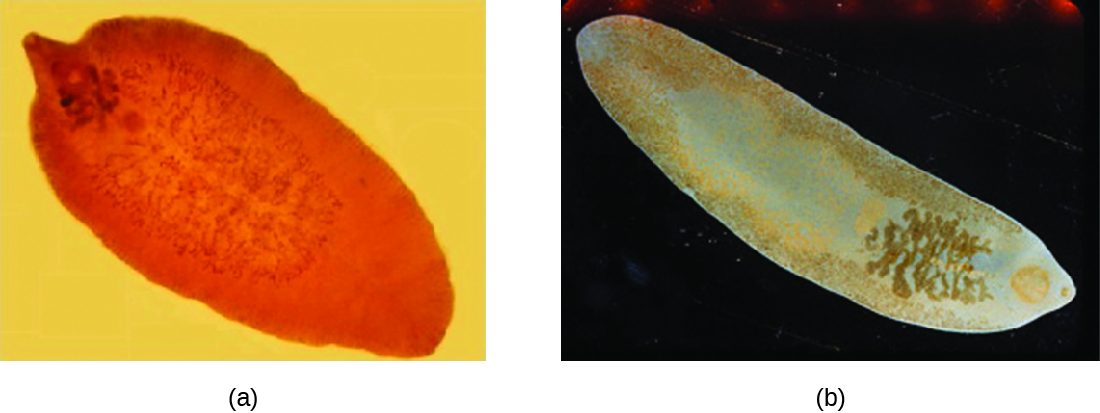| << Chapter < Page | Chapter >> Page > |
Flukes are flatworms that have a leaflike appearance. They are a type of trematode worm, and multiple species are associated with disease in humans. The most common are liver flukes and intestinal flukes ( [link] ).

The liver flukes are several species of trematodes that cause disease by interfering with the bile duct. Fascioliasis is caused by Fasciola hepatica and Fasciola gigantica in contaminated raw or undercooked aquatic plants (e.g., watercress). In Fasciola infection, adult flukes develop in the bile duct and release eggs into the feces. Clonochiasis is caused by Clonorchis sinensis in contaminated freshwater fish. Other flukes, such as Opisthorchis viverrini (found in fish) and Opisthorchis felineus (found in freshwater snails), also cause infections. Liver flukes spend part of their life cycle in freshwater snails, which serve as an intermediate host. Humans are typically infected after eating aquatic plants contaminated by the infective larvae after they have left the snail. Once they reach the human intestine, they migrate back to the bile duct, where they mature. The life cycle is similar for the other infectious liver flukes, (see [link] ).
When Fasciola flukes cause acute infection, signs and symptoms include nausea, vomiting, abdominal pain, rash, fever, malaise, and breathing difficulties. If the infection becomes chronic, with adult flukes living in the bile duct, then cholangitis, cirrhosis, pancreatitis, cholecystitis, and gallstones may develop. Symptoms are similar for infections by other liver flukes. Cholangiocarcinoma can occur from C. sinensis infection. The Opisthorchis species can also be associated with cancer development.
Diagnosis is accomplished using patient history and examination of samples from feces or other samples (such as vomitus). Because the eggs may appear similar, immunoassay techniques are available that can help distinguish species. The preferred treatment for fascioliasis is triclabendazole . C. sinensis and Opisthorchis spp. infections are treated with praziquantel or albendazole .
The intestinal flukes are trematodes that develop in the intestines. Many, such as Fasciolopsis buski , which causes fasciolopsiasis , are closely related to liver flukes. Intestinal flukes are ingested from contaminated aquatic plants that have not been properly cooked. When the cysts are consumed, the larvae emerge in the duodenum and develop into adults while attached to the intestinal epithelium. The eggs are released in stool.
Intestinal fluke infection is often asymptomatic, but some cases may involve mild diarrhea and abdominal pain. More severe symptoms such as vomiting, nausea, allergic reactions, and anemia can sometimes occur, and high parasite loads may sometimes lead to intestinal obstructions.

Notification Switch
Would you like to follow the 'Microbiology' conversation and receive update notifications?